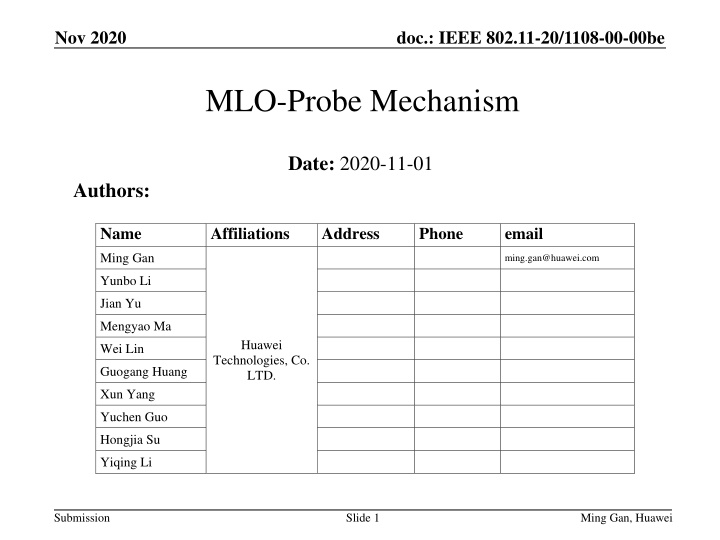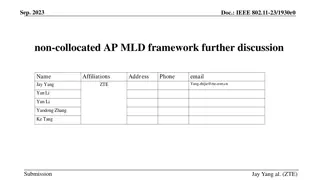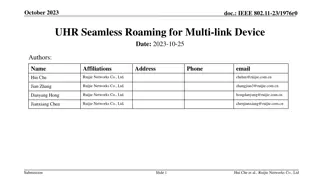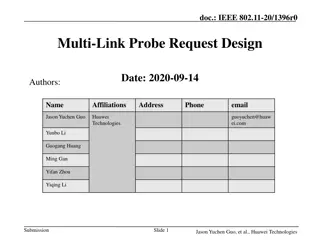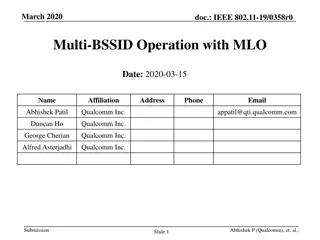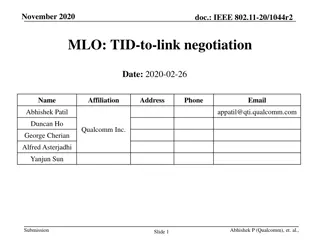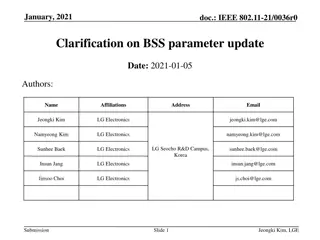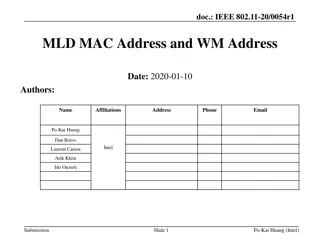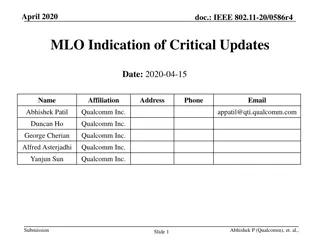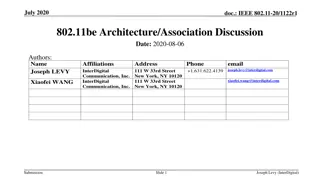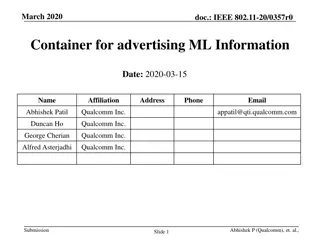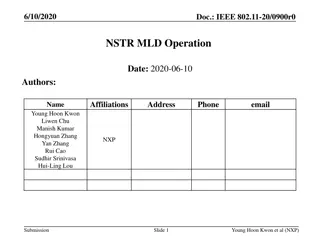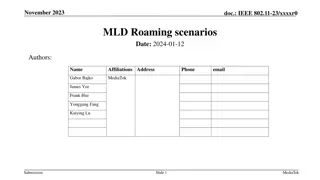IEEE 802.11-20/1108-00-00be MLO Probe Mechanism in AP MLD
This document discusses the design and implementation of a mechanism for a non-AP STA to send a probe request frame to an AP within an AP MLD, allowing the STA to request a probe response containing information on all APs affiliated with the same MLD as the target AP. It proposes the use of new elements and frame formats to enable efficient communication and data retrieval within multiple BSSID sets. Various contributions and proposals related to the ML probe mechanism are examined in-depth in this detailed technical document.
Download Presentation

Please find below an Image/Link to download the presentation.
The content on the website is provided AS IS for your information and personal use only. It may not be sold, licensed, or shared on other websites without obtaining consent from the author.If you encounter any issues during the download, it is possible that the publisher has removed the file from their server.
You are allowed to download the files provided on this website for personal or commercial use, subject to the condition that they are used lawfully. All files are the property of their respective owners.
The content on the website is provided AS IS for your information and personal use only. It may not be sold, licensed, or shared on other websites without obtaining consent from the author.
E N D
Presentation Transcript
Nov 2020 doc.: IEEE 802.11-20/1108-00-00be MLO-Probe Mechanism Date: 2020-11-01 Authors: Name Affiliations Address Phone email Ming Gan ming.gan@huawei.com Yunbo Li Jian Yu Mengyao Ma Huawei Wei Lin Technologies, Co. LTD. Guogang Huang Xun Yang Yuchen Guo Hongjia Su Yiqing Li Submission Slide 1 Ming Gan, Huawei
Nov 2020 doc.: IEEE 802.11-20/1108-00-00be Background We agree to define a mechanism for a STA of a non-AP MLD to send a probe request frame to an AP belonging to an AP MLD, which enables to request a probe response from the AP that includes the complete set of capabilities, parameters and operation elements of other APs affiliated to the same MLD as the AP The complete information is defined as all elements that would be provided if the reported AP was transmitting that same frame (exceptions TBD) ML element with ML Probe request [1] could be used for this mechanism A few contributions [2] [3] and [4] have touched the design for ML Probe mechanism In this contribution, we discuss the Probe mechanism related to AP MLD from legacy support Submission Slide 2 Ming Gan, Huawei
Nov 2020 doc.: IEEE 802.11-20/1108-00-00be ML Probe In [4], it proposed to use new element to solicit the info of a few APs or all the APs in an AP MLD as follows Element ID Length Number Of Link ID Fields Link ID Octets: 1 1 1 Variable However in [2], it proposes to reuse ML element to solicit the above info Probe Request Frame Durati on A1 A2 A3 Sequence Control HT Multi-Link Element FCS Frame Control Control All of them need a new element, changing the frame format of the Probe Response frame Submission Slide 3 Ming Gan, Huawei
Nov 2020 doc.: IEEE 802.11-20/1108-00-00be Regular Probe Like Multiple BSSID feature, we propose that the AP could respond the Probe Response frame on behalf of the solicited AP that is in the same AP MLD In Multiple BSSID set, transmitted BSSID responds with a Probe Response frame instead of the solicited non-tx BSSID This mechanism could reuse the regular Probe Request frame to solicit the info of any single AP in an AP MLD. Submission Slide 4 Ming Gan, Huawei
Nov 2020 doc.: IEEE 802.11-20/1108-00-00be Regular Probe We propose a STA that receives a Probe Request frame shall not respond if any of the following apply: b)The Address 1 field of the Probe Request frame contains an individual address and one of the following criteria is met: 1) The STA is not a member of a multiple BSSID set, and the individual address is not the MAC address of the STA. 2) The STA is a member of a multiple BSSID set, and the individual address does not match the BSSID of any of the BSSs in the multiple BSSID set. 3) The STA is affiliated with a MLD, and the individual address does not match the MAC address of any of the APs in the MLD Otherwise, the STA that receives a Probe Request frame shall respond with a Probe Response frame Submission Slide 5 Ming Gan, Huawei
Nov 2020 doc.: IEEE 802.11-20/1108-00-00be Regular Probe We propose a STA that receives a Probe Request frame shall not respond if any of the following apply: h) The STA is not a mesh STA and the Address 3 field of the Probe Request frame does not contain a wildcard BSSID and one of the following criteria is met: 1) The STA is not a member of a multiple BSSID set and the Address 3 field of the Probe Request frame does not match the BSSID of the STA s BSS(#2599). 2) The STA is a member of a multiple BSSID set and the Address 3 field of the Probe Request frame does not match the BSSID of any of the BSSs in the multiple BSSID set. 3) The STA is affiliated with a MLD, and the Address 3 field of the Probe Request frame does not match the BSSID of any of the BSSs in the MLD . Otherwise, the STA that receives a Probe Request frame shall respond with a Probe Response frame Submission Slide 6 Ming Gan, Huawei
Nov 2020 doc.: IEEE 802.11-20/1108-00-00be Example An individual addressed Probe Request frame is sent on 2.4 GHz to solicit the info of another AP (AP 2) This individual addressed Probe Request frame is sent by a legacy STA or an EHT STA in a non-AP MLD An AP in an AP MLD shall provide the info of another AP in the same AP MLD when it receives the Probe Request that solicits the info of that AP AP 2 The regular Probe Request frame that solicits the info of AP2, the RA is set to AP s address AP1/ 2.4G Legacy STA or EHT STA in non-AP MLD AP2/ 5G The Probe Response frame frame that providing the info of AP2 AP3/ 6G Submission Slide 7 Ming Gan, Huawei
Nov 2020 doc.: IEEE 802.11-20/1108-00-00be Discussion EHT STA can could reuse the regular Probe Request to solicit the info of single AP in the AP MLD for the following cases Switch one link to another link A change to the value of CSN of single AP in the AP MLD Request partial info of single AP in the AP MLD, no any change to the Regular Probe Request since it already carries Request Element Moreover, the typical case is dual band MLD especial for non-AP MLD, so probing the info of single AP is also typical since the info of transmitting AP could be obtained by the Beacon or unsolicited Probe Response Besides soliciting the info of single AP in an AP MLD by EHT STA, this Regular Probe Request could also be used for legacy support RNR becomes a very important tool for an AP or AP MLD discovery mechanism Although the new field like MLD Parameter is added, legacy STAs (like HE STA) can still parse the RNR element correctly, i.e., it could get enough info based on the first 13 octets in TBTT info field of RNR element In this way, legacy STAs could reuse regular Probe Request to find a proper AP among the APs in the AP MLD that is provided in RNR element Neighbor AP TBTT Offset 20 MHz PSD MLD parameters BSSID (optional) Short-SSID (optional) BSS parameters 0 or 1 0 or TBD Octets: 1 0 or 6 0 or 4 0 or 1 Submission Slide 8 Ming Gan, Huawei
June 2020 doc.: IEEE 802.11-20/1108-00-00be Summary In this contribution, we propose to reuse the regular Probe Request frame for ML Probe which could solicit the info of a single AP in an AP MLD This regular Probe Request frame could be used for legacy support. Submission Slide 9 Ming Gan, Huawei
June 2020 doc.: IEEE 802.11-20/1108-00-00be References [1] 11-20-0772-05-00be-multi-link-element-format [2] 11-20-1396-01-00be-multi-link-probe-request-design [3] 11-20-1141-00-00be-restrictions-on-mld-probe [4] 11-20-1255-00-00be-pdt-mac-mlo-discovery-discovery- procedures-including-probing-and-rnr Submission Slide 10 Ming Gan, Huawei
June 2020 doc.: IEEE 802.11-20/1108-00-00be SP 1 Do you agree to reuse the regular (non-ML) Probe Request frame to solicit the info of any single AP in an AP MLD? Submission Slide 11 Ming Gan, Huawei
Nov 2020 doc.: IEEE 802.11-20/1108-00-00be SP 2 Do you agree to reuse the regular (non-ML) Probe Request frame with either Address 1 field or Address 3 field set to the MAC address of an AP in an AP MLD to solicit the info of that AP in the AP MLD? Submission Slide 12 Ming Gan, Huawei
